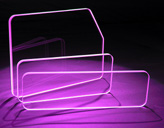Sheet Glass – Quality flat glasses for technical applications
On this page, you will find an overview about our technical-grade clear flat glass and microsheet materials.
Our technical-grade sheet glasses are manufactured by advanced float glass processes or are directly drawn into glass sheets. They offer an optical quality that goes far beyond what ordinary glass can offer. These glass types are highly transparent and feature smooth and mostly fire-polished surfaces, which often give better flatness, surface quality, and particularly microroughness than a conventional mechanical polishing process could offer. All our sheet glass materials are available in various standard thicknesses with a tight nominal thickness tolerances. We cut and process these sheet materials to any size and shape required. Please follow the links to each datasheet to view the respective specifications and to display the typical optical transmission curves of each of the sheet glass types listed below:

Selected White Float Glass
Our selected float glass is a universal, cost-effective flat glass with reduced iron content. It is a technical-grade sheet glass with excellent optical properties, visible light transmission, and very smooth surfaces with low micro-roughness. We sort and select this glass for the best surfaces and flatness. The material is produced in a thickness of 0.40–4.00 mm.
Further details on selected float glass...
BOROFLOAT® Borosilicate Glass
BOROFLOAT® is a borosilicate glass material with exceptional light transmittance, outstanding thermal properties, and superb chemical resistance. It is highly transparent in the upper UV-wavelength range, especially at smaller thicknesses, and can often replace much more expensive quartz glass in applications that do not require deep UV transmission.
Further details about BOROFLOAT®...
B 270® – Superwite
The water-white and crystal-clear crown glass B 270 is a drawn flat glass material for universal optical applications. It offers a steady transmission for visible light and can even reach optical quality after it has been mechanically polished.
Further details on B 270®...
EAGLE XG® from CORNING®
The alkali-free glass EAGLE XG® offers very low microroughness and has a coefficient of expansion close to that of silicon. The high-performance clear sheet glass is suitable for wafer-level optics manufacturing.
More details on EAGLE XG®...
1737F Glass
1737F aluminosilicate glass has a near-zero alkali glass composition. This clear specialty glass can withstand the rigorous thermal cycles of polysilicate transistor processes. Hence, it is regularly used for semiconductor applications. The sheet glass is the replacement and successor material for 7059F low alkali glass.
More details about 1737F...
EAGLE2000 Lightweight Glass
EAGLE2000 lightweight alkaline earth boro-aluminosilicate sheet glass has a near zero alkali composition. The glass is ideal for AMLCD and COG (chip-on-glass) applications. It has excellent flatness, and a low mechanical density. More details on EAGLE2000...
7059 Barium-Borosilicate Glass
7059 is a baria-alumina-borosilicate glass that contains near-zero alkalies. The glass composition offers unique electrical characteristics that are critical for applications in the semiconductor industry. More details on 7059...
In most cases, our quality sheet glasses for optical applications do not require additional expensive mechanical polishing processes, as they naturally exhibit exceptional optical quality and flatness. Almost any of the listed transparent glasses can be cut precisely with CNC machines, resulting in considerable cost savings for the customer's end product. They typically feature a very smooth surfaces, superior optical flatness, display-grade performance, and a very low micro-roughness, which is often better than what is achievable with an expensive optical polishing process. Hence, the glass types in this category are the ideal choice for many demanding bulk applications. They offer superior glass grade and optimum light transmission while maintaining the cost control required.
Are you looking for a technical sheet-glass material not listed in this overview?
If you cannot find the flat-glass type you are looking for above, or need help selecting the appropriate material, please consider using our information inquiry form. We stock and process many more exotic technical flat glasses that might not be listed here. If you are searching for even thinner transparent glass, please visit our thin-glass page.
Note: We do not offer acrylic or other plastic sheets. Those plastic and acrylic materials cannot provide the performance usually required for optical applications.
© 1994 – 2025 Präzisions Glas & Optik GmbH
Last update: November 21, 25


